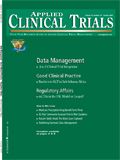Electronic Data Lifecycle Management
Applied Clinical Trials
To capitalize on technology, a new approach to managing data is needed. Peg Regan, chief executive officer for PharmaPros Corporation, explains the concept of Electronic Data Lifecycle Management and how it will improve the quality of data and the time it takes to access it.
Companies engaged in clinical trials are seeing a paradigm shift in the very definition of clinical data management. What was once a paper-based, manual process focused on one trial at a time is evolving into a technology-based, automated process that operates across multiple studies.

Peg Regan
There have been an ever expanding number of data sources being incorporated into clinical trials, such as EDC, ePRO, IVRS, CTMS, as well as new types of electronic lab data. Sponsor companies have been attempting to take on the challenges of integrating and managing these data sources, and as a result, the technology—which in most cases is outside the scope of their core competencies.
This makes for an untenable situation, which will continue to be a pressing issue for sponsor companies and CROs alike until a holistic approach to managing electronic data is implemented.
Management redefined
What was once a "black box," where data went in one end and came out the other, is becoming a multidisciplinary process with new possibilities for access and visibility into the data. But simply adding electronic to clinical data management is not going to close the process gaps that are being revealed as companies implement new technologies.
In order to capitalize on the real value these new technologies offer, there needs to be a wholesale shift in the way we think about the possibilities of managing data electronically.
If there is a new moniker, it is Electronic Data Lifecycle Management (eDLM): an approach to gain comprehensive visibility into the entire electronic data lifecycle that enables faster access to better quality data at each step—from FPI through archival. Instead of waiting for data to inform our decisions, an eDLM approach promotes proactive, real-time access to data (Labs, Sites, ePRO, CDMS, CTMS, safety, etc.), leveraging data repositories to provide upstream visibility into study metrics, enabling time-critical decisions and adaptive trial designs. Ideally, there would be a combination of in-house and outsourced expertise to manage eDLM. In-house staff would work across multiple studies with data project leaders savvy in automated trial design and data tracking and reporting tools. We would see a new breed of service providers, such as data integrators and aggregators, who would act as a trusted third party somewhere between the sponsor, CRO, and technology vendor.
These service providers would integrate the data sources, design workflow, and aggregate data into repositories, providing a comprehensive view from which to extrapolate and cross analyze the data through the use of standards.
IT trial model
With an increased number of vendors and diverse skill sets becoming involved in clinical research, the roles within the eDLM approach will demand strong interpersonal skills and the ability to manage seemingly disparate functions as one integrated team.
All of these roles will require technological savvy and the ability to adapt in an ever expanding and complex environment.
By combining the expertise of data, technology, and workflow to create a layer of services that acts as a bridge between the functionality of a software application and the sponsor's study design, between the sites and the CRO, and between the patient and caregiver, we will essentially create an IT model for trials that has been successful in every other major industry.
These are exciting times for sure, but for those who think managing clinical data is a thing of the past, think again. While it may be very different, we will still have people managing data. The difference is that they will be managing the entire electronic lifecycle of the data, and no longer from a silo operation. Rather, they will be working along side the other functions as part of an integrated, multidisciplinary team.
